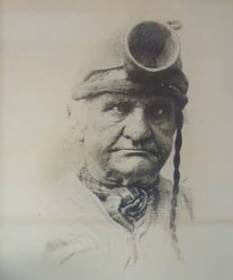
Old Malabar
(Photo courtesy of Lukas Reichenbach)
The juggler known as Old Malabar was born Patrick Feeney in Sligo, Ireland on February 20, 1800. He was the son of a poor farmer. A weak student in school, he longed to travel to see the world beyond the farm. His brothers gave him thirty shillings to start his journey and Patrick left to see the world. Patrick headed to Dublin, where he struggled to find employment and quickly ran low on money. He journeyed to Liverpool, England, where he thought there would be better chances for employment. Shortly after arriving in Liverpool, Patrick Feeney saw a performance by a Chinese juggler named either Tusang or Tusany. Fascinated by the performance, Feeney attached himself to the juggler as an apprentice. Tusang / Tusany provided room and board for the boy, who served the Chinese performer faithfully for several years as he also learned the juggler’s tricks and routines. The Chinese performer gave Patrick the stage name of Malabar. Eventually, the two formed a two person act. When Patrick was ready to go solo, he traveled to Scotland, which became his favorite place to perform. Audiences took note of him right away, as he stood 6 feet, 4 inches tall, dressed in exotic Asian clothing, and had very strongly marked facial features. They quickly became admirers of Patrick’s genial personality as well as his great skill. He gave his first performance in Glasgow during the Fair of 1822.
Malabar became a fixture at horse races, fairs, and other events throughout Scotland, England, and Ireland. He juggled balls, rings, bottles, daggers, swords, Japanese tops, and diabolos. His act was described as “manly and graceful,” with ongoing patter that was modest and humorous. He caught a cannon ball on his neck, balanced a heavy coach-wheel on his chin, turned somersaults, and swallowed swords. While he occasionally performed in theaters, the vast majority of his work was done like a modern street performer, passing a plate to the crowd that he had worked to gather.
He was most famous for two tricks. The first of these was catching a small but heavy brass ball that he tossed high into the air in a metal cup that was strapped to his forehead with leather. Malabar was occasionally a heavy drinker, and he once got drunk on whisky before a show. When he went to perform the cup trick, he missed and hit himself in the face, resulting in a large scar and flattened nose. This made him swear off alcohol for a time. This trick was so associated with Malabar that most photos and illustrations of the juggler show him with the cup strapped to his head.


Amazingly, Old Malabar’s brass ball and the cup he wore on his head have not been lost to time. They are currently on display at Kelvin Hall in Glasgow, Scotland, along with his diabolos and some other props.

(Photo courtesy of Lukas Reichenbach)

(Photo courtesy of Lukas Reichenbach)
The second trick that brought Malabar fame was certainly one that would gain the audience’s attention. As his grand finale, he would tie an adult donkey to a tall, 16-rung ladder. Malabar would then pass a plate around to the audience, saying that if they filled the plate with money, he would then balance the ladder (and donkey) on his chin. The audience would do as instructed and the juggler would carry through with the trick, much to the crowd’s delight.

Malabar famously performed the ladder and donkey balance at a horse race for King George IV, who gave him a gold coin for his efforts. Years later, after the donkey had died, Malabar performed the trick with an older boy atop the ladder. One day Malabar drank too much and lost the balance and the ladder and boy came crashing down onto the heads of the audience. The trick eventually was cut from the act as Malabar grew older and became known as Old Malabar.
Old Malabar was a much beloved character in the British Isles for six decades. Unlike many other street performers, he wasn’t looked upon as a beggar or madman. He was married for forty years and his wife assisted him in his performances during that time. He didn’t care about the fashion of the day, wearing his performing costume, which included a waist belt inscribed with his name, all day, every day, despite his surroundings. Malabar loved the freedom of street performing, eschewing working through an agent or manager like the jugglers found in theaters and music halls. He was famous for always having a positive attitude toward life and others.
Old Malabar passed away on November 6, 1883. He had performed up to the end, having given a performance just the day before. He was remembered in various books and magazines and even had his memoirs published many decades after his passing.


